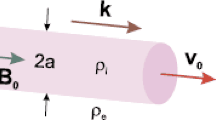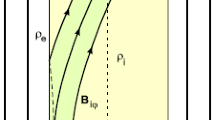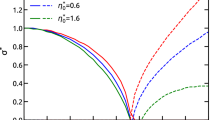Abstract
We investigate the conditions at which high-mode magnetohydrodynamic (MHD) waves propagating in a spinning solar macrospicule can become unstable with respect to the Kelvin–Helmholtz instability (KHI). We consider the macrospicule as a weakly twisted cylindrical magnetic flux tube moving along and rotating around its axis. Our study is based on the dispersion relation (in complex variables) of MHD waves obtained from the linearized MHD equations of an incompressible plasma for the macrospicule and cool (\(\beta = 0\), with \(\beta\) the plasma to the magnetic pressure) plasma for its environment. This dispersion equation is solved numerically using appropriate input parameters to find out an instability region or window that accommodates suitable unstable wavelengths on the order of the macrospicule width. It is established that an \(m = 52\) MHD mode propagating in a macrospicule with width of 6 Mm, axial velocity of \(75~\mbox{km}\,\mbox{s}^{-1}\), and rotating one of \(40~\mbox{km}\,\mbox{s}^{-1}\) can become unstable against the KHI with growth times of 2.2 and 0.57 min at 3 and 5 Mm unstable wavelengths, respectively. These growth times are much shorter than the macrospicule lifetime, which lasts about 15 min. An increase or decease in the width of the jet would change the KHI growth times, which remain more or less of the same order when they are evaluated at wavelengths equal to the width or radius of the macrospicule. It is worth noting that the excited MHD modes are super-Alfvénic. A change in the background magnetic field can lead to another MHD mode number, \(m\), that ensures the required instability window.




Similar content being viewed by others
References
Ajabshirizadeh, A., Ebadi, H., Vekalati, R.E., Molaverdikhani, K.: 2015, The possibility of Kelvin–Helmholtz instability in solar spicules. Astrophys. Space Sci. 367, 33. DOI .
Banerjee, D., O’Shea, E., Doyle, J.G.: 2000, Giant macro-spicule as observed by CDS on SOHO. Astron. Astrophys. 355, 1152. ADS .
Bennett, S.M., Erdélyi, R.: 2015, On the statistics of macrospicules. Astrophys. J. 808, 135. DOI .
Bennett, K., Roberts, B., Narain, U.: 1999, Waves in twisted magnetic flux tubes. Solar Phys. 185, 41. DOI .
Bohlin, J.D., Vogel, S.N., Purcell, J.D., Sheeley, N.R. Jr., Tousey, R., VanHoosier, M.E.: 1975, A newly observed solar feature: macrospicules in He ii 304 Å. Astrophys. J. 197, L133. DOI .
Chandrasekhar, S.: 1961, Hydrodynamic and Hydromagnetic Stability, Clarendon Press, Oxford. Chap. 11.
Culhane, J.L., Harra, L.K., James, A.M., et al.: 2007, The EUV Imaging Spectrometer for Hinode. Solar Phys. 243, 19. DOI .
De Pontieu, B., McIntosh, S., Hansteen, V.H., et al.: 2007, A tale of two spicules: the impact of spicules on the magnetic chromosphere. Proc. Astron. Soc. Japan 59, S655. DOI .
De Pontieu, B., Rouppe van der Voort, L., McIntosh, S.W., et al.: 2014, On the prevalence of small-scale twist in the solar chromosphere and transition region. Science 346, 1255732. DOI .
Domingo, V., Fleck, B., Poland, A.I.: 1995, SOHO: the Solar and Heliospheric Observatory. Space Sci. Rev. 72, 81. DOI .
Ebadi, H.: 2016, Kelvin–Helmholtz instability in solar spicules. Iranian J. Phys. Res. 16, 41. DOI .
Golub, L., Deluca, E., Austin, G., et al.: 2007, The X-Ray Telescope (XRT) for the Hinode Mission. Solar Phys. 243, 63. DOI .
Goossens, M., Hollweg, J., Sakurai, T.: 1992, Resonant behaviour of MHD waves on magnetic flux tubes. III. Effect of equilibrium flow. Solar Phys. 138, 233. DOI .
Harrison, R.A., Fludra, A., Pike, C.D., Payne, J., Thompson, W.T., Poland, A.I., Breeveld, E.R., Breeveld, A.A., Culhane, J.L., Kjeldseth-Moe, O., Huber, M.C.E., Aschenbach, B.: 1997, High-resolution observations of the extreme ultraviolet Sun. Solar Phys. 170, 123. DOI .
Howard, T.A., Moses, J.D., Vourlidas, A., et al.: 2008, Sun Earth Connection Coronal and Heliospheric Investigation (SECCHI). Space Sci. Rev. 136, 67. DOI .
Iijima, H., Yokoyama, T.: 2017, Three-dimensional magnetohydrodynamic simulation of the formation of solar chromospheric jets with twisted magnetic field lines. Astrophys. J. 848, 38. DOI .
Kaiser, M.L., Kucera, T.A., Davila, J.M., et al.: 2008, The STEREO Mission: an introduction. Space Sci. Rev. 136, 5. DOI .
Kamio, S., Curdt, W., Teriaca, L., Inhester, B., Solanki, S.K.: 2010, Observations of a rotating macrospicule associated with an X-ray jet. Astron. Astrophys. 510, L1. DOI .
Kayshap, P., Srivastava, A.K., Murawski, K., Tripathi, D.: 2013, Origin of macrospicule and jet in polar corona by a small-scale kinked flux tube. Astrophys. J. 770, L3. DOI .
Kiss, T.S., Gyenge, N., Erdélyi, R.: 2017, Systematic variations of macrospicule properties observed by SDO/AIA over half a decade. Astrophys. J. 835, 47. DOI .
Kosugi, T., Matsuzaki, K., Sakao, T., et al.: 2007, The Hinode (Solar-B) Mission: an overview. Solar Phys. 243, 3. DOI .
Kuridze, D., Zaqarashvili, T.V., Henriques, V., Mathioudakis, M., Keenan, F.P., Hanslmeier, A.: 2016, Kelvin–Helmholtz instability in solar chromospheric jets: theory and observation. Astrophys. J. 830, 133. DOI .
Lemen, J.R., Title, A.M., Akin, D.J., et al.: 2012, The Atmospheric Imaging Assembly (AIA) on the Solar Dynamics Observatory (SDO). Solar Phys. 275, 17. DOI .
Loboda, I.P., Bogachev, S.A.: 2017, Plasma dynamics in solar macrospicules from high-cadence extreme-UV observations. Astron. Astrophys. 597, A78. DOI .
Madjarska, M.S., Vanninathan, K., Doyle, J.G.: 2011, Can coronal hole spicules reach coronal temperatures? Astron. Astrophys. 532, L1. DOI .
Miura, A.: 1984, Anomalous transport by magnetohydrodynamic Kelvin–Helmholtz instabilities in the solar wind–magnetosphere interaction. J. Geophys. Res. 89, 801. DOI .
Murawski, K., Srivastava, A.K., Zaqarashvili, T.V.: 2011, Numerical simulations of solar macrospicules. Astron. Astrophys. 535, A58. DOI .
Parenti, S., Bromage, B.J.I., Bromage, G.E.: 2002, An erupting macrospicule: characteristics derived from SOHO-CDS spectroscopic observations. Astron. Astrophys. 384, 303. DOI .
Pesnell, W.D., Thompson, B.J., Chamberlin, P.C.: 2012, The Solar Dynamics Observatory (SDO). Solar Phys. 275, 3. DOI .
Pike, C.D., Harrison, R.A.: 1997, Euv observations of a macrospicule: evidence for solar wind acceleration? Solar Phys. 175, 457. DOI .
Pike, C.D., Mason, H.E.: 1998, Rotating transition region features observed with the SOHO Coronal Diagnostic Spectrometer. Solar Phys. 182, 333. DOI .
Ryu, D., Jones, T.W., Frank, A.: 2000, The magnetohydrodynamic Kelvin–Helmholtz instability: a three-dimensional study of nonlinear evolution. Astrophys. J. 545, 475. DOI .
Scullion, E., Doyle, J.G., Erdélyi, R.: 2010, A spectroscopic analysis of macrospicules. Mem. Soc. Astron. Ital. 81, 737. ADS .
Vernazza, J.E., Avrett, E.H., Loeser, R.: 1981, Structure of the solar chromosphere. III – models of the EUV brightness components of the quiet-sun. Astrophys. J. Suppl. 45, 635. DOI .
Wilhelm, K., Curdt, W., Marsch, E., et al.: 1995, SUMER – Solar Ultraviolet Measurements of Emitted Radiation. Solar Phys. 162, 189. DOI .
Zank, G.P., Matthaeus, W.H.: 1993, Nearly incompressible fluids. II: magnetohydrodynamics, turbulence, and waves. Phys. Fluids 5, 257. DOI .
Zaqarashvili, T.V., Erdélyi, R.: 2009, Oscillations and waves in solar spicules. Space Sci. Rev. 149, 355. DOI .
Zaqarashvili, T.V., Vörös, Z., Zhelyazkov, I.: 2014, Kelvin–Helmholtz instability of twisted magnetic flux tubes in the solar wind. Astron. Astrophys. 561, A62. DOI .
Zaqarashvili, T.V., Zhelyazkov, I., Ofman, L.: 2015, Stability of rotating magnetized jets in the solar atmosphere. I. Kelvin–Helmholtz instability. Astrophys. J. 813, 123. DOI .
Zaqarashvili, T.V., Díaz, A.J., Oliver, R., Ballester, J.L.: 2010, Instability of twisted magnetic tubes with axial mass flows. Astron. Astrophys. 516, A84. DOI .
Zhelyazkov, I.: 2012, Magnetohydrodynamic waves and their stability status in solar spicules. Astron. Astrophys. 537, A124. DOI .
Zhelyazkov, I.: 2013, Kelvin–Helmholtz instability of kink waves in photospheric, chromospheric, and X-ray solar jets. In: Zhelyazkov, I., Mishonov, T. (eds.) Space Plasma Physics: Proceedings of the 4th School and Workshop on Space Plasma Physics, AIP Conf. Proc. 1551, 150. DOI .
Zhelyazkov, I., Chandra, R.: 2018, High mode magnetohydrodynamic waves propagation in a twisted rotating jet emerging from a filament eruption. Mon. Not. Roy. Astron. Soc. 478, 5505. DOI .
Zhelyazkov, I., Chandra, R., Srivastava, A.K.: 2016, Kelvin–Helmholtz instability in an active region jet observed with Hinode. Astrophys. Space Sci. 361, 51. DOI .
Zhelyazkov, I., Zaqarashvili, T.V.: 2012, Kelvin–Helmholtz instability of kink waves in photospheric twisted flux tubes. Astron. Astrophys. 547, A14. DOI .
Zhelyazkov, I., Zaqarashvili, T.V., Ofman, L., Chandra, R.: 2018, Kelvin–Helmholtz instability in a twisting solar polar coronal hole jet observed by SDO/AIA. Adv. Space Res. 61, 628. DOI .
Acknowledgements
Our work was supported by the Bulgarian Science Fund under project DNTS/INDIA 01/7. The authors are indebted to the anonymous reviewer for pointing out a mathematical error and for the helpful and constructive comments and suggestions that contributed to improving the final version of the manuscript.
Author information
Authors and Affiliations
Corresponding author
Ethics declarations
Disclosure of Potential Conflicts of Interest
The authors declare that they have no conflicts of interest.
Additional information
Publisher’s Note
Springer Nature remains neutral with regard to jurisdictional claims in published maps and institutional affiliations.
Appendix A: Derivation of the Wave Dispersion Relation
Appendix A: Derivation of the Wave Dispersion Relation
We recall that we modeled the spinning macrospicule as a rotating and axially moving twisted magnetic flux tube of radius \(r = a\). In a cylindrical coordinate system, the magnetic and velocity fields inside the jet are assumed to be
respectively. Linearized ideal MHD equations, which govern the incompressible dynamics of perturbations in the rotating jet, are
where \(\boldsymbol{v} = (v_{r}, v_{\phi }, v_{z})\) and \(\boldsymbol{b} = (b_{r}, b_{\phi }, b_{z})\) are the perturbations of fluid velocity and magnetic field, respectively, and \(p_{\mathrm{tot}}\) is the perturbation of the total pressure \(p_{\mathrm{t}}\).
Assuming that all perturbations are proportional to \(g(r)\exp [\mathrm{i} ( -\omega t + m \phi + k_{z} z ) ]\), with \(g(r)\) being just a function of \(r\), we obtain from the above set of equations the following ones:
where
is the Doppler-shifted frequency and
It is now convenient to introduce the Lagrangian displacement, \(\boldsymbol{\xi }\), and express it via the fluid velocity perturbation through the relation (Chandrasekhar, 1961)
which yields
In terms of \(\boldsymbol{\xi }\), Equations 12 – 18 can be rewritten as
where
is the local Alfvén frequency inside the jet.
Excluding \(\xi _{\phi }\) and \(\xi _{z}\) from these equations, we obtain
where
By presenting \(\xi _{r}\) from Equation 28 in terms of \(p_{\mathrm{tot}}\) and inserting it into Equation 27, we obtain the following equation for the total pressure perturbation:
This equation can be significantly simplified by considering that the rotation and the magnetic twist of the jet are uniform, that is,
where \(\Omega \) and \(A\) are constants. In this case, Equation 29 takes the form of the Bessel equation
where
The equation governing plasma dynamics outside the jet (without twist and velocity field, i.e. \(A = 0\), \(\Omega = 0\), and \(U_{z} = 0\)) is the same Bessel equation, but \(\kappa _{\mathrm{i}}\) is replaced by \(k_{z}\).
Inside the jet, the solution to Equation 31 bounded on the jet axis is the modified Bessel function of the first kind,
where \(\alpha _{\mathrm{i}}\) is a constant.
Outside the jet, the solution bounded at infinity is the modified Bessel function of the second kind,
where \(\alpha _{\mathrm{e}}\) is a constant.
To obtain the dispersion equation governing the propagation of MHD modes along the jet, the solutions at the jet surface need to be merged through boundary conditions.
It is well known that for non-rotating and untwisted magnetic flux tubes, the boundary conditions are the continuity of the Lagrangian radial displacement and total pressure perturbation at the tube surface (Chandrasekhar, 1961), that is,
where total pressure perturbations \(p_{\mathrm{tot\,i}}\) and \(p_{\mathrm{tot\,e}}\) are given by Equations 33 and 34, respectively.
When the magnetic flux tube is twisted and still non-rotating and the twist has a discontinuity at the tube surface, then the Lagrangian total pressure perturbation is continuous and the boundary conditions are (see, e.g., Bennett, Roberts, and Narain, 1999; Zaqarashvili et al., 2010; Zaqarashvili, Vörös, and Zhelyazkov, 2014)
The second term in the second boundary condition stands for the pressure from the magnetic tension force.
If a non-twisted, \(B_{\mathrm{i}\phi } = 0\), tube rotates and the rotation has discontinuity at the tube surface, the boundary condition for the Lagrangian total pressure perturbation has a similar form as the second boundary condition in Equation 36,
Here, the second term that describes the contribution of the centrifugal force to the pressure balance can be derived from Equation 28 for \(B_{\mathrm{i}\phi } = 0\) by multiplying that equation by \(\mathrm{d}r\), and considering the limit of \(\mathrm{d}r \to 0\) through the boundary \(r = a\), one obtains the relation \(\mathrm{d} [ p_{\mathrm{tot}} + (\rho _{\mathrm{i}} U _{\phi }^{2}/a)\xi _{r} ] = 0\), or, equivalently, the second boundary condition in the above equation. Hence, the boundary condition for the Lagrangian total pressure perturbation in rotating and magnetically twisted flux tubes has the form
In the case of uniform rotation and magnetic field twist, Equation 30, the boundary conditions for the Lagrangian radial displacement \(\xi _{r}\) and the total pressure perturbation \(p_{\mathrm{tot}}\) are
Using these boundary conditions, we obtain the dispersion equation of normal MHD modes propagating in rotating and axially moving twisted magnetic flux tubes (Zaqarashvili, Zhelyazkov, and Ofman, 2015)
where
We note that in the case of a non-rotating twisted flux tube, \(\Omega = 0\), the above Equation 40 recovers the well-known dispersion relation of normal MHD modes propagating in cylindrical twisted jets (see, e.g., Zhelyazkov and Zaqarashvili, 2012). If the environment medium is a cool plasma, as is the case of our macrospicule, where the thermal pressure \(p_{\mathrm{e}} = 0\), the \(k_{z} a\) in \(P_{m}(k_{z} a)\) must be replaced by \(k_{z} a[ 1 - ( \omega / \omega _{\mathrm{Ae}} )^{2} ]^{1/2}\), which yields the wave dispersion relation we used in Equation 3.
Rights and permissions
About this article
Cite this article
Zhelyazkov, I., Chandra, R. Can High-Mode Magnetohydrodynamic Waves Propagating in a Spinning Macrospicule Be Unstable Due to the Kelvin–Helmholtz Instability?. Sol Phys 294, 20 (2019). https://doi.org/10.1007/s11207-019-1408-8
Received:
Accepted:
Published:
DOI: https://doi.org/10.1007/s11207-019-1408-8




